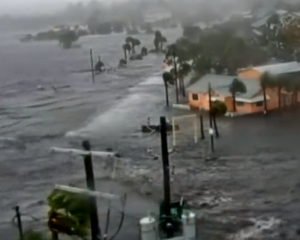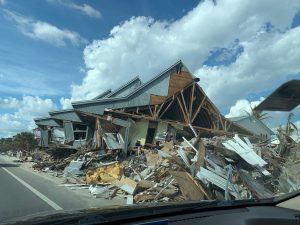Mexico’s surprisingly devastating Hurricane Otis proves that predicting hurricane intensification can be a tricky business, the three-week countdown begins to the end of the official Atlantic hurricane season that appears to have petered-out, plus the spoils of Hurricane Ian on Fort Myers Beach.

A high-rise building in Acapulco, Mexico after Hurricane Otis
Hurricane Otis: When Hurricane Otis hit Mexico’s Pacific coast on October 25 it came ashore as a Category 5 hurricane with winds of 165 mph and torrential rains – even though the U.S. National Hurricane Center (NHC) predicted it at Category 1 (74-95 mph winds) strength. At least 45 people are dead and dozens of others are still missing. The Associated Press article Forecasters were caught off guard by Otis’ growth quotes NHC Director Michael Brennan is quoted as saying the East Pacific is a huge data void and that forecasters have many more tools to measure Atlantic storms. Meteorologists say “rapid intensification” (+35 mph within 24 hours) has become more common among cyclones in the past couple of decades but Otis’ wind speeds increased by 110 mph in 24 hours.
Otis damaged more than 200,000 homes and the tourist resort community of Acapulco is a mess, with high-rise hotels and condos looking especially decimated. Gallagher Re estimates insured losses “considerably into the billions of dollars.” The strongest storm ever to hit Mexico’s Pacific coast will “become one of the most expensive events, if not the highest, on record for the Mexican insurance market,” said Gallagher Re. “Given the scale of damage to several high-end commercial properties, this will be a notable driver of the insured payouts.”

Hurricane Idalia’s storm surge washes through Steinhatchee, August 30, 2023. Courtesy, WCJB-TV.
Our Hurricane Season: Back here in Florida, storm activity anywhere close to the Southeast U.S. coast essentially ceased within a couple of weeks of Hurricane Idalia striking the Big Bend region on August 30. Updated figures last week put the Cat 4 storm’s estimated insured losses in Florida at $287.8 million on 24,500 claims, with just over 71% of claims closed and maintaining a paid to unpaid ratio of 3:2. Idalia was the only Atlantic hurricane to make landfall this year and together with Tropical Storms Harold in Texas and Ophelia in North Carolina, made up the 19 named storms so far this year. 2023 will still be considered an above-normal year versus NOAA’s May prediction for a “near normal” season of 12 to 17 named storms.
As for the rest of the season, which officially ends November 30? Meteorologist Bryan Norcross on his HurricaneIntel website declares the 2023 hurricane season on pause – for now. The National Hurricane Center as of yesterday (Sunday, November 5) said the chance of tropical formation through the next seven days was near 0%.

A series of homes destroyed on Ft. Myers Beach during Hurricane Ian, November 6, 2022. Courtesy, Kevin Miller
Hurricane Opportunities: The Insurance Journal recently featured an interesting Bloomberg story titled “Ravaged Fort Myers Becomes Magnet for Risk-Taking Property Buyers.” It’s a very informative read about some individuals and developers who are buying-up parts of Fort Myers Beach severely damaged or destroyed in Hurricane Ian in September 2022. “The influx of money into Fort Myers Beach is helping to make some people whole, filling gaps that insurance won’t cover and even providing profits for some of those whose homes were destroyed. But these sellers are forced to leave a community they can no longer afford, using their cash to build a life somewhere cheaper and farther from the front lines of climate change,” according to the story. These are some of the same points made in my past May Florida Insurance Roundup podcast. Dr. David Prevatt and Dr. Karthik Ramanathan discussed the choices Florida faces in rebuilding storm-ravaged barrier islands and their economic – as well as societal – costs.


